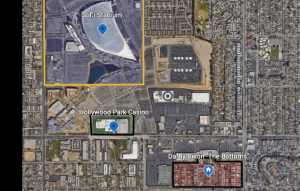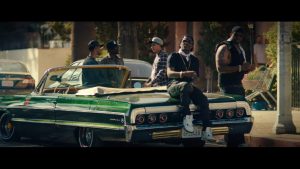
Inglewood, California provides the backdrop for much of Dope. The city is a part of the greater Los Angeles area, and this general aesthetic is present throughout the film. Malcolm is from a specific neighborhood in Inglewood called The Bottoms, which is known as one of the roughest neighborhoods in Los Angeles. Inglewood has been known for years as a multicultural, low to middle-class community, but, since the release of Dope, Inglewood has undergone a number of changes that have gentrified much of the city. In 2016, the St. Louis Rams announced they would be relocating to Los Angeles, with the brand new SoFi Stadium hosting the team. The San Diego Chargers made the same move shortly after. SoFi Stadium is now the gleaming center of Inglewood, having hosted a Super Bowl, and plans to hold games of the 2026 FIFA World Cup and even the 2028 Olympics [1. Garrett, Ural. “Forget the Rams and NFL: What will happen to Inglewood’s growing Hip-hop scene?” Hip-HopDX, January 14, 2016.
]. Dope provides a fascinating time capsule of Inglewood before all of these changes brought by the Rams and Chargers. The film takes place in the “present day” of 2015, right before the Rams and Chargers announced their moves to Inglewood. While there are some aspects of the film that discuss gentrification more broadly, these are few and far between, and have no connection to the changes brought by the NFL. For example, at 52 minutes, as Malcolm attempts to make it to his Harvard interview, Lily, played by Chanel Iman, can be seen running towards a “Seven Bucks,” a not-so-subtle play on Starbucks, which is often seen as a harbinger of gentrification.
In order to understand the role Inglewood plays in Dope, it is also important to know the history of the most prominent music genre to come out of Inglewood and other communities in Los Angeles with a substantial Black population: Gangsta Rap. Gangsta Rap falls under the broader hip-hop umbrella, and arose in the 90s. It traces its roots to the economic and social instability of the 1970s and 80s. During this time, many manufacturing jobs moved out of the United States and relocated to other countries like China. These manufacturing jobs, particularly in the Los Angeles ares, were primarily staffed by people of color, and when the jobs left, they had to find other means to supplement their income [2. Quinn, Eithne. Nuthin’ but a “G” Thang : the Culture and Commerce of Gangsta Rap. New York: Columbia University Press, 2005.]. Some turned to selling drugs in order to earn extra cash. Dealing was incredibly dangerous. This was during the height of the War on Drugs, which meant many dealers and others involved in the illegal drug industry were facing threats from law enforcement, along with other gangs. Those who lived in communities where this conflict was pervasive sought a sense of catharsis, and Gangsta Rap provided that catharsis [3. Quinn, Eithne. Nuthin’ but a “G” Thang : the Culture and Commerce of Gangsta Rap. New York: Columbia University Press, 2005.]. Many of the most prominent Gangsta Rap artists like NWA were from Compton, which has played a much larger role in the history of rap, Inglewood’s role is not insignificant, being the home of Gangsta Rapper Mack 10, along with other prominent artists like Omarion, Cali Swag District, Jean Dawson and Casey Veggies, who can be seen performing in the club scene of Dope.

The music in Dope plays a vital role in setting the scene of Inglewood. The soundtrack includes songs from 90s hip hop legends like Nas and A Tribe Called Quest, along with more current songs from artists like Kali Uchis, Buddy and Dom actor A$AP Rocky. The music helps to create a more immersive environment for the viewer. Malcolm’s life, along with the lives of many from Inglewood, is full of music. In order to accurately reflect Malcolm’s upbringing, it is necessary for music to not only be present, but be brought to the foreground when it needs to be. Often, when filmmakers are attempting to design the setting for their movies, they focus primarily on the visual aspects of their setting. This is key, but for Dope, the visual setting was easy to establish. Los Angeles is of course the home of the United States’ film industry, so it was not difficult for Famuyiwa to shoot almost all of the film on location. This left more opportunity for the setting to be conveyed through audio. It would be almost impossible to tell the story Dope is trying to tell without the music, showing just how key audio is to establishing a setting in audiovisual media.